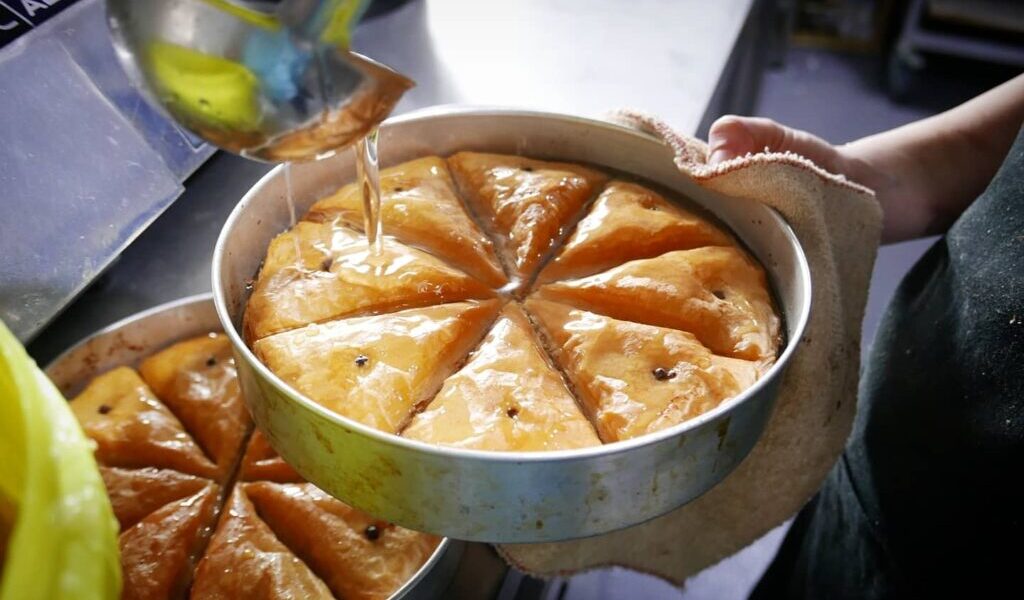Indulge in the exquisite delight of traditional Greek Baklavas (pronounced Mpah-klah-VHASS), a captivating dessert that weaves layers of crisp, golden-brown phyllo into a delectable tapestry. Nestled within this masterpiece are finely chopped nuts, enveloped in an irresistible embrace of scented honey syrup. The distinctive pronunciation, Mpah-klah-VHAS, sets this treat apart from the term "baklava" (BAH-klah-vah) used elsewhere.
A glimpse into the history of Baklavas reveals a tapestry of origins that have been debated over time. Stakeholders ranging from the Turks, Arabs, Jews, Armenians, and Bulgarians have each claimed Baklavas as their national dessert. However, its roots trace back to the Byzantine era, emerging long before the Ottomans' conquest of Constantinople.
The Ottoman Empire's expansion facilitated Baklavas' introduction to the nations they conquered. Yet, its beginnings can be traced back to Ancient Greece, where a similar treat named "gastrin" or "koptoplakous" captivated palates. These ancestral names drew inspiration from the Greek term "plakous", meaning thin or layered flatbreads. Romans embraced this culinary tradition and referred to it as "placenta."
A mention of the Cretan dessert "Gastrin" dates back to the 3rd century AD in Athenaeus's literary work "Deipnosofistae". This sweet concoction featured Thasian nuts, Pontic nuts, almonds, and poppy seeds expertly toasted and blended with honey. "Gastrin" found its place in the heart of Ancient Greece long before its enduring journey into contemporary Baklavas.
Ancient text:
..ἐν Κρήτῃ δέ, φησίν, πλακουντάριον ποιοῦσιν, ὅπερ ὀνομάζουσι γάστριν. γίνεται δέ οὕτως· κάρυα Θάσια καί Ποντικά καί ἀμύγδαλα, ἔτι δέ μήκων, ἃ φρύξας θεράπευσον καλῶς καί εἰς θυίαν καθαρά τρῖψον ἐπιμελῶς· συμμίξας τε τήν ὀπώραν μάλαξον μέλιτι ἡψημένῳ, προσβαλών πέπερι πλέον καί μάλαξον· γίνεται δέ μέλαν διά τήν μήκωνα. διαπλατύνας ποίησον τεράγωνον· εἶτα σήσαμον λευκόν τρίψας μάλαξον μέλιτι ἡψημένῳ καί ἕλκυσον λαγάνια δύο καί ἓν θές ὑποκάτω καί τό ἄλλο ἐπάνω, ἵνα τό μέλαν εἰς μέσον γένηται, εὖ ῥύθμισόν τε αὐτό. ταῦτα καό ὁ σοφός πεμματολόγος Χρύσιππος.
Free translation:
On Crete, he says (referring to Chrysippus), they produce a small cake they call gastrin. It is made as follows: Use some Thasian nuts (walnuts), Pontic nuts (hazelnuts) and almonds, along with some poppy seeds; toast them, keeping a close eye on them as you do, and mash them fine in a clean mortar; mix the fruit in and work it smooth along with some reduced honey; add a considerable amount of pepper and work it smooth. It turns out black because of the poppy seed. Flatten it out into a square. Next, grate white sesame seed; work it into a paste with reduced honey; press it into two sheets, putting one on the bottom and the other on top of it so that the black mixture can go in the middle; and assemble it nicely. Thus the wise pastry-expert Chrysippus. (Chrysippus of Tyana was a Greek writer on gastronomy).
Modern interpretations of this ancient delight reveal an intricate interplay of flavours, often combining honey and petimezi— a sweetener crafted from grapes. The legacy of Baklavas continues to unfold, echoing the rich tapestry of Greek gastronomic history.
Typically, baklava is made with at least four layers of phyllo dough and two to three layers of nuts and syrup. Some elaborate recipes call for up to 12 layers of phyllo dough and five or more layers of nuts and syrup. But Greek bakers and households make it with 33 dough layers, referring to the years of Jesus’ life.
For the Recipe click here

